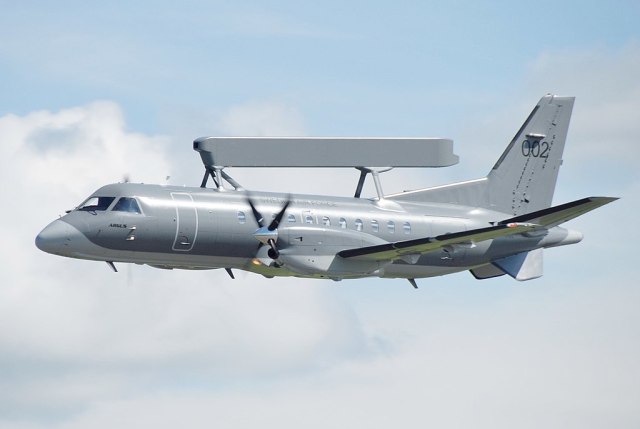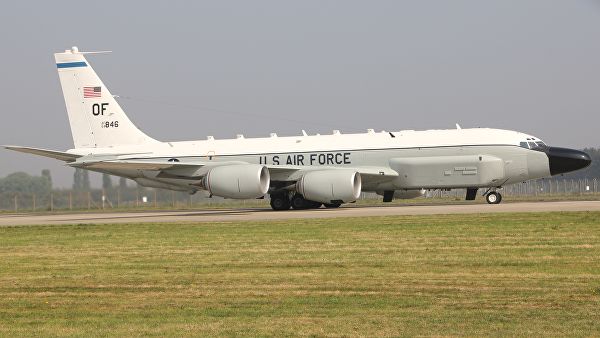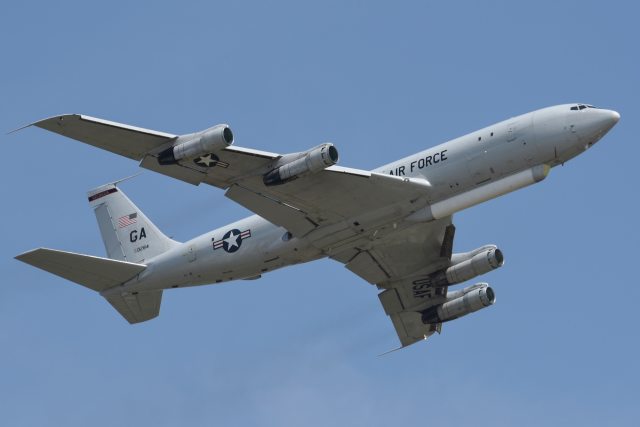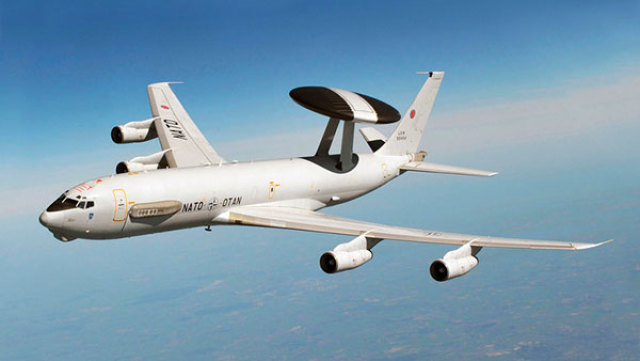In 2022, one of the main signs of the ongoing special operation in Ukraine was the active work of Western military intelligence. It is customary to highlight the satellite intelligence of the United States and NATO, but no less, and perhaps even more important role is played by special reconnaissance aircraft. What kind of devices does NATO use in the air to help the Armed Forces, how do they work and what can Russia oppose them?What are Western reconnaissance planes studying, looking at the territory of Ukraine?
Almost the entire ground situation.
The resolution of their side-view radar makes it possible to identify ground targets the size of a motorcycle. That is, it is not easy to detect a certain self-moving iron box, but to give out exactly: five tanks, coordinates; howitzer, coordinates; SAM, coordinates; aircraft of this type, its coordinates. Some aircraft are even able to listen to wired and radio relay lines. So reconnaissance aviation is very unpleasant.
However, these planes also have their limitations. It is commonly believed that reconnaissance planes observe both the air and the ground. In fact, no, each of them performs its own functions.
Boeing E-3A Sentry aircraft ("Sentry")These machines do not conduct ground reconnaissance.
Their task is to scout the airspace. We often call these machines AWACS (AWACS, Airborne Warning and Control System), but in fact the E-3A Sentry is only part of this system. In the Russian tradition, these machines are called AWACS (long-range radar detection).
The curvature of the Earth's surface is the most important factor of radar reconnaissance. A ground–based radar (conventional, not short–wave over–the-horizon), if standing on a high-rise, can detect a fighter flying at an extremely low altitude - up to 200 m - at a range of 30-40 km, a cruise missile at an altitude of 50 m - at a range of 23-30 km. This is the physical limit. It is called "radiogorizont". The higher the radar is, the further it can look beyond the radio horizon.
The Boeing E-3A Sentry is much more powerful in this sense. From its cruising altitude (about nine kilometers), it can detect a bomber at medium and high altitudes at a range of 600 km, a fighter at low altitude – 360 km, a cruise missile at extremely low altitude – 260 km, a surface ship at a range of more than 400 km. Above the fuselage of the aircraft is, as the Americans say, a "Rotode" – a huge rotating lentil-shaped fairing in which a phased array radar is installed. The crew consists of 20-22 people, of which four are pilots, 14-16 are operators, a radar equipment engineer and one or two technicians. The flight duration is 11 hours.
The second important function of this aircraft is to guide fighters to aerial targets. That is, it can serve as an aviation command post. Therefore, a large set of equipment of all types of communication is installed on it. Information about the air situation from its side can be transmitted in real time to various ground, surface objects, command posts using various digital exchange protocols. The most versatile communication line is Link 16. Its equipment is installed at many Ukrainian command posts, the RK-360 "Neptune" anti-ship complex. Thus, the air defense of Ukraine receives information about the air situation sufficient not to turn on its radars during raids until the moment when it is necessary to open fire.
However, there is an important subtlety. The "sentry", as a rule, continuously moves along a route of about 1.5 thousand km along the western borders of Ukraine and over the Black Sea. Therefore, he cannot always be in the "right place, at the right time". Taking into account all the restrictions, they eventually view the territory to a depth of only 200-250 km and only in the west of the country. In other words, Ukraine's air defense cannot fully rely on such assistance. Maybe the E-3A Sentry will give information about the approach of Russian aircraft or cruise missiles – or maybe not.
Boeing E-3A Sentry with AWACS system is not the only NATO AWACS aircraft operating near Ukraine.
S-100B Argus with FSR-890 AWACS system
A much simpler and low-power flying radar made in Sweden. It patrols at altitudes from two to six kilometers, has a low-power radar, cannot boast of a significant target detection range. For a six-kilometer flight altitude, the range for large aircraft does not exceed 400 km, for small–sized ones at low altitudes - 150-200 km.
 |
| S-100B Argus. |
| Source: Gnolam/Wikipedia |
A special feature is a fixed antenna with a phased array. Its 9x0.8 m canvas is mounted vertically (on the smaller side) above the fuselage in a flat fairing. Because of this design, the aircraft does not provide a circular view of the airspace, it views it only in two sectors of 120 degrees sideways from the route. A maneuver is required to view the "dead zones". The crew consists of two pilots and four operators.
These were AWACS aircraft, their reconnaissance can be considered quite conditionally.
RC-135V or RC-135W Rivet Joint
This is the first important NATO reconnaissance aircraft operating against the Russian Armed Forces. The main aircraft of electronic reconnaissance (RER).
How much blood and sweat of Soviet and Russian air defense officers drank these devices! Those of them who served in a strip of several hundred kilometers from the border had to run to the ready position No. 1 several times a day and track these aircraft for hours. Fighters on duty were hoisted up it. In Soviet times, such actions were especially characteristic in the Far East. Having a supply of kerosene for 15 hours of flight, the RC-135V walked along our borders, and after using up fuel, slowly moved 50-100 km away from them to the KC-135 air tanker, refueled – and again to the border.
 |
| USAF electronic reconnaissance aircraft Boeing RC-135V Rivet Joint. |
| Source: CC BY 2.0 / Jerry Gunner / 64-14846 / OF RC-135V 55 SRW 45 RS |
In the Soviet years, several more such aircraft operated over the Sea of Okhotsk (which was not considered our internal at that time) and the Pacific Ocean, American reconnaissance ships were at sea, and at key moments of the Boeing route, American satellites passed over this area. With radio intelligence stations on board, operating 800 km sideways from the course, RC-135 detected Soviet air defense facilities and many other parts and objects in those parts.
Today, this particular aircraft is the most malicious of the entire NATO reconnaissance squadron flying around Ukraine. In particular, it is he who informs the APU about the rise of Russian long-range aviation. Its radio interception equipment directs the operation of all means of communication at airfields – from the radio belonging to the tanker driver to the radio station of the flight director, switching on to check on-board radars and radio altimeters. And according to this data, it determines exactly when, how many and what types of bombers are preparing for takeoff. After takeoff, it continues to track the bombers on the route. Therefore, for the air defense of Ukraine, it is often no secret when and what exactly the long-range aviation of the Russian Aerospace Forces will strike.
When Ukrainian UAVs hit the airfields of Engels and Diaghilev, the RC-135 had the most important function – to determine when there would be gaps in our radar field due to the failure of some radars or their withdrawal for maintenance, etc. According to these data, the enemy has already laid out a route.
Aircraft RER S102B Korpen ("Raven")
The purpose of these machines is to open positions and analyze the parameters of the operation of air defense radars. Interacts with the RC-135W Rivet Joint. Owned by Sweden, manufactured in the amount of two units. It flies from the Baltic to the eastern part of the Black Sea. The intelligence equipment is controlled by an artificial intelligence system. The crew consists of two pilots and two or four operators.
RC-12 Huron – Guardrail Tactical Electronic Reconnaissance Aircraft
Engaged in radio interception. Patrolling over Lithuania. The area of interest is the Baltic States, Kaliningrad region, Belarus. The crew is two pilots, there are no reconnaissance equipment operators. All this equipment is fully automated and transmits the received information to the ground center in real time.
EP-3E Aries II long-range RER aircraft
Aries belongs to the US Navy. Converted from a patrol anti-submarine aircraft and successfully combines the function of an electronic warfare aircraft and an anti-submarine aircraft. It patrols mainly near the coast of Bulgaria and Romania, but sometimes makes flights to Georgia.
Anti-submarine patrol aircraft ATR-72 ASW (Anti-Submarine Warfare)
It has an advanced sensor system, including radar with headlights, which, although it can detect aerial targets, is still specialized for surface targets. And you will be surprised, but it can search for submarines. Moving underwater at depths of up to 300 m, a submarine creates a wave above itself on the surface of the sea, invisible to human eyes, but perfectly observed by radar equipment. Such a wave received the slang name "Bernoulli's hump". Operates over the Black Sea. In particular, the areas near the exit to it from the Bosphorus Strait are carefully monitored.
It also has weapons – Harpoon missiles, small-sized anti-submarine torpedoes Mk45, Mk54, dropped radio hydroacoustic buoys for searching submarines.
Northrop Grumman RQ-4 Global Hawk UAV
Strategic high-altitude reconnaissance unmanned aircraft. The largest combat drone in the world. The wingspan is 35 m, the weight is about 15 tons. Purpose – ground reconnaissance. Patrol parameters: altitude about 20 km, time - 38 hours, speed 840 km /h (mod. "A") or 640 km/ h (mod. "B").
| jpg">American strategic reconnaissance UAV RQ-4 Global Hawk. |
| Source: © CC0 / Public Domain, U.S. Air Force photo by Bobbi Zapka |
The only American serious UAV that they occasionally risk conducting over the territory of Ukraine. Equipped with a simplified version of the reconnaissance equipment installed on the manned high-altitude reconnaissance U-2 (TR-1). The most important element is the radar (side–view radar). It works with a so-called synthesized aperture antenna. A radar with such a small antenna makes several radar images sequentially according to the movement of the device, which are processed directly on board by the processor. As a result, a single high-quality image with a size of several tens of meters is obtained. At the same time, the resolution of linear dimensions of objects is provided – one meter. The information is transmitted to the control center via a satellite communication channel of 50 Mbit/s.
The small power of such a radar does not allow to achieve a long range of such reconnaissance, but 110 km is provided. However, neither we nor the Americans have reported anything about how effective such a radar is in the conditions of setting it active interference.
Bombardier Challenger 650 Artemis
Reconnaissance and target designation aircraft. The most classified US reconnaissance aircraft to date. It has not been put into service, one car belongs to private companies LASAI AVIATION LLC and TENAX AEROSPACE LLC, working for the Pentagon under a contract. Judging by what can be seen from the outside, as well as by the analysis of the radiation of its radio-electronic means, it is equipped with a high-resolution side-view radar, as well as a large set of antennas for bearing and identifying signals from ground radars and radio stations. There is no doubt that in real time it will be able to give out the exact types and coordinates of ground-based technical objects from the howitzer to the communications center, SAM, OTRK.
Northrop Grumman E8C Joint Stars
The chief scout of the ground situation. The same airframe of the passenger Boeing-707 was used as that of the E3 Sentry, RC-135, KS-135.
 |
| Northrop Grumman E8C Joint Stars. |
| Source: af.mil |
The Joint STARS reconnaissance system is installed on the E8C, and the aircraft is often called by its name. It is based on a side-view radar with SAR (antenna with synthesized aperture). It has a length of 26 m and is installed under the fuselage in a special "canoe" type fairing. Such a large SAR size makes it possible to obtain radar images of photographic (!) quality at a reconnaissance range of up to 200 km . Another advantage of the aircraft is that it can provide not just reconnaissance of ground targets, but also control the use of tactical and operational-tactical weapons on them and evaluate the results.
In fact, a whole flying headquarters. Crew: four pilots, 17 JSTARS operators. But there are redundant automated workplaces – and if necessary, it can be increased.
* * *As a result, it is worth noting that all these devices can be effective only in the absence of counteraction to them.
Counteraction can be a disguise, electronic warfare, and other, more straightforward ways. In particular, there is reason to believe that the "accidental" launch of a missile near the British RC-135W in the fall cooled the ardor of NATO air scouts. Even with a fighter escort, we flew for a while. But they quickly calmed down and continued to spy. Countering Western aerial reconnaissance remains one of the main tasks that the Russian Armed Forces must and are solving right now in Ukraine.
Igor Galaburda

